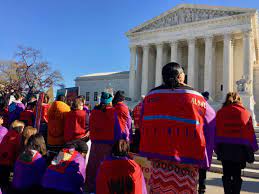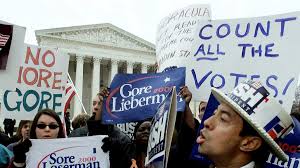Tribal sovereignty describes the inherent authority of independent Indigenous tribes to govern themselves within a separate nation’s borders, in this case, within the borders of the United States. The United States Constitution, in its original draft, mentions Native Americans twice: once to exclude the Native population from the population count used in congressional apportionment (which would later be amended by the 14th Amendment), and once to grant Congress the power to regulate commerce with Native nations and foreign nations, which the text places in the same category. These two clauses imply that tribal sovereignty was originally assumed in the Constitution, as Native peoples were viewed as outside of the United States citizenry and analogous to citizens of foreign nations. The Constitution itself does not explicitly challenge tribal sovereignty, and yet, tribal sovereignty scarcely exists in our modern world. The Supreme Court, little by little, has made sure of that.
The Marshall Trilogy is a set of three Supreme Court cases from the early 19th century that combined to define the legal and political rights of Native communities in early America, and they are the first examples of the Supreme Court adjudicating away Native rights. Johnson v. M’Intosh (1823) prohibited private citizens from purchasing land from Native Americans; Cherokee Nation v. Georgia (1831) established the Cherokee Nation as a dependent ward to the United States Federal Government; and Worcester v. Georgia (1832) granted the federal government the sole authority to interact with Native nations. The Marshall Trilogy, while recognizing some aspects of Native sovereignty, significantly limited its scope. Thus the judicial process of chipping away at tribal sovereignty had begun, and I will argue that this judicial colonial impulse persisted into the 20th century.
In the decades since the Marshall Trilogy, the Supreme Court has continued its march down the colonial path, stripping tribes of sovereignty one carefully written opinion at a time. Oliphant v. The Suquamish Indian Tribe (1979) constitutes one such example. Scholar Geoffrey C. Heisey observes that prior to the Oliphant decision, there existed a “tripartite division of criminal justice” that gave federal, state, and tribal courts “varying degrees of criminal jurisdiction based on different concepts of sovereignty,” describing the three party, collaborative justice system that previously existed (Heisey 1053). Oliphant, in removing tribal jurisdiction over non-Natives, “removed the most practical and logical body for administering criminal justice on the reservations,” describes Heisey, emphasizing the harmful effects of this decision on the wellbeing, safety, and sovereignty of reservation communities (Heisey, 1998). In the wake of Oliphant, hundreds of misdemeanor level crimes committed by non-Natives on reservations go unpunished annually, as the federal government considers itself far too busy to routinely prosecute minor crimes such as intoxicated driving, assault, vandalism, and petty theft. By removing tribal jurisdiction over misdemeanor offenses, Oliphant created a safe-haven for white crime, thereby subjecting Native populations to increased dangers without offering any recourse to punish offenders.
In Oliphant v. Suquamish Indian Tribe (1978), the Court claimed to find solid legal ground for a harmful, racist decision, but a close reading of the rhetoric in both the oral arguments offered by counsel and the opinions issued by the Court reveals that solid ground to be quite shaky, if not altogether fractured. The petitioner’s reliance on hyperbolic rhetoric resulted in an increased burden of proof for the respondents, resulting in the justices implementing far more pointed rhetorical attacks on the counsel for the respondent. This rhetorical power dynamic in the oral argument proceedings ultimately resulted in a Supreme Court opinion that relies on rhetoric involving revisionist history, vague and inferred logical reasoning, and condescending diction and typography. These rhetorical techniques employed by the Court allowed the justices to disguise racism within the language of the law, and their ultimate decision obeyed the judicial colonial tradition despite having little limited legal justification.
Before analyzing the rhetoric of the case, it is imperative to have a general understanding of the facts of Oliphant. In August of 1973, the Suquamish Tribe was planning a three day festival called Chief Seattle Days. Expecting large crowds, the tribe requested reinforcement from county and federal law enforcement, the former of which sent one deputy, the later of which sent none. At 4:30 in the morning during the festival, Mark Oliphant (a non-Native permanent resident on the Port Madison Indian Reservation in Washington) was arrested for assaulting a tribal officer and resisting arrest. After being detained and held in county jail, Oliphant filed a writ of habeas corpus in federal court, asserting that he, as a non-Native, was not subject to tribal authority, and thus his arrest was unconstitutional. Lower courts rejected his petition, but the 9th Circuit Court agreed to hear the case. After hearing the case, the circuit court upheld tribal criminal jurisdiction. Oliphant immediately appealed to the Supreme Court, where the judgment of the circuit court was overturned in favor of a ruling for the petitioner. Rhetoric, I argue, successfully obscured the racist motivations of the Supreme Court in deciding Oliphant.
In critically analyzing the oral argument proceedings in Oliphant, the petitioner’s method of argument appears entirely based in rhetorical manipulation. Phillip Malone and Slade Gorton, counsel for Mark Oliphant, consistently utilize hyperbolic language to overzealously describe the dangers of allowing tribal jurisdiction, attempting to instill fear in the Justices before the respondent takes the stand. Central to their argument is an assertion of ideal individual rights. “In our view,” says Gorton, “tribal self government ends where the common self government of all citizens begins” (Oliphant v. Suquamish Indian Tribe (1978), Oral Argument). By drawing this comparison between tribe sovereignty and individual sovereignty, Gorton uses parallelism to infer that allowing tribes to exercise jurisdiction over non-Natives in courts outside of the federal court system opens the door for individuals to question the authority of the federal government, constituting a gross extrapolation and a large jump in logical reasoning. Gorton continues this hyperbolic fear mongering throughout his argument. “Until 1968,” says Gorton, “this Indian tribe could have hung a non-Indian for burglary without offering him any constitutional rights whatsoever,” intentionally choosing the most extreme of examples for this hyperbolic rhetorical strategy (Oliphant, Oral Argument). By grounding the argument in a hyperbolic tone of alarm, counsel for the petitioner seeks to convince the Court that the harm of allowing tribal jurisdiction outweighs the tribe’s interest in sovereignty, thus using rhetorical maneuvering to disguise a racist assertion.
As the petitioner delivers oral arguments first, counsel for the respondent was greeted by a Court already on the defensive. Aware of their fighting an uphill battle, counsel for the respondent grounds their arguments in extensive historical epithets, statutory language, and sophisticated legal theory — leaving no room for exaggeration, inference, or speculation. Their method was not rhetorical manipulation, but evidentiary reasoning. And yet, despite the comparatively solid ground on which the respondent’s argument rests, Barry Ernstoff and his fellow counsel are met with far more pointed and contentious questioning from the bench. Towards the end oral argument, Justice Marshall and Ernstoff engage in a heated debate, bouncing back and forth for the better part of five minutes:
“Thurgood Marshall: What do you point to other than an opinion of this Court?
Ernstoff: It is impossible to point —
Marshall: Then the answer is you do not have anything?
Ernstoff: Yes, the answer is that Congress has never —
Marshall: Your answer is that you do not have anything?” (Oliphant, Oral Argument)
As evidenced by this interaction, counsel for the respondents were met with hostility from the bench from the outset —the results of the petitioner’s rhetorical fear mongering. While the petitioner was not interrupted mid-sentence even once during oral argument, the respondent fielded these judicial hardballs nonstop. The tone, frequency, and urgency of the justices questioning evidences the judicial predisposition to side with the petitioners.
Despite the disparities in the validity of legal justifications offered by counsels in oral argument, the Supreme Court decided in a 6-2 decision for the petitioner. The opinion issued by the court and authored by Justice Rehnquist selectively references history, consistently utilizes vague language and flawed logical reasoning, and regularly employs condescending diction in order to disguise a racist, harmful decision in legal rhetoric. Though at face value the decision may seem based on solid legal ground, a close reading reveals the flaws in foundation at the heart of the Oliphant decision.
Throughout the opinion of the Court, history is used to justify the removal of tribal jurisdiction — but only a very particular, carefully selected version of history. Rehnquist writes that “by submitting to the overriding sovereignty of the United States, Indian tribes necessarily yield the power to try non-Indians,” therefore describing the practice of colonization as a voluntary surrender of power by the tribes to a benevolent United States (Oliphant v. Suquamish Indian Tribe, 191). This narrative could not be further from the truth, but revising history proves beneficial to the legal justification, for if this were true, the logic would be sound. Additionally, Rehnquist continues by giving a half hearted attempt at Native history, but ironically, he only begins this history with American settlement. “Two hundred years ago, the area consisted of a large number of politically autonomous Indian villages, each occupied by from a few dozen to over 100 Indians. These loosely related villages were aggregated into a series of Indian tribes,” writes Rehnquist, condensing a rich history of compromise, governance, cohabitation, warfare, and culture into a narrow time frame and a meager two sentences (Oliphant, 192). By simplifying history as such and ignoring the forced geographical condensation of Native peoples by American colonists, Rehnquist selectively references history in order to utilize epithets that argue for concentration of power being a natural evolution in governmental systems. Our choice of allusions are arguments as well, and Rehnquist’s choice illustrates his determination to find for the petitioner.
An analysis of the opinion offered by the Court also reveals a heavy reliance on vague language and flawed logical reasoning, thereby revealing the fragility of the legal argument asserted therein. Rehnquist continues his argument that tribes voluntarily surrendered jurisdiction by writing that relinquishing jurisdiction is “a fact which seems to be recognized by the Treaty of Point Elliott,” though the language appears nowhere in the treaty (Oliphant, 191). The choice of “seems to be” is an example of rhetorical obscurity, as to say this agreement is recognized by the treaty would be factually inaccurate. The vague language allows Rehnquist to portray a convenient interpretation as statutory fact, but a close reading reveals the falsehood of his assertion. Throughout the opinion, diction of uncertainty, vagueness, and inference abound. An act of Congress that did not speak to tribal jurisdiction is said to “suggest that” Congress shared the view of the Executive branch … that Indian tribal courts were without jurisdiction to try non-Indians” (Oliphant, 203); congressional actions in the 19th century reveal an “unspoken assumption” of a lack of tribal jurisdiction (Oliphant, 203); and the “commonly shared presumption” among federal branches “that tribal courts do not have the power to try non-Indians carries considerable weight” (Oliphant, 206).
In addition to these egregiously vague justifications relying on an imperfect inference of public opinion, the court additionally relies on imperfect, faulty logical reasoning. The court writes, in all seriousness, that the Native nations “must depend on the Federal Government for protection from intruders,” not considering for a moment that the Federal Government itself is the intruder from whom Native nations have historically desired protection (Oliphant, 205). Though at first glance the logical justifications of such a decision may appear sound, the Court intentionally implements vague language and leaps in logical reasoning in order to disguise their racism as legally permissible through rhetorical maneuvers.
In perhaps the most explicit display of racism in Oliphant, the opinion of the Court consistently incorporates condescending, patronizing diction that serves to unduly judge the quality of Native nations by American standards. The condescension begins in the first paragraph, as the court writes that “it was assumed that the tribes, few of which maintained any semblance of a formal court system, did not have such jurisdiction” (Oliphant, 191). By emphasizing the lack of a “formal court system,” the court looks down upon Native nations for their failure to resemble American systems of governance. By implying that American courts are a formal court system, the inference is that Indigenous modes of accountability, punishment, and retribution are informal, and thus inferior. Additionally, the opinion refers to the incident leading to Oliphant’s arrest as an “alleged high speed race,” thus doubting the facts as presented by tribal authorities through the word “alleged” (Oliphant, 194). The insults only grow more apparent, as Rehnquist later quotes, and affirms, the 1834 Commissioner of Indian Affairs: “The Indian tribes are without laws, and the chiefs without much authority to exercise any restraint” (Oliphant, 197). By referencing this quote in support of his argument, Rehnquist relies on a century old mass generalization of Indigenous peoples, a patronizing attitude towards Native nations, and an explicitly racist rhetorical method.
Furthermore, racism is not hidden within diction alone, but also within typography. Rehnquist writes that “ ‘indian law’ draws principally upon the treaties drawn,” and the use of quotation marks coupled with a refusing capitalization is far from unintentional (Oliphant, 206). By placing the words “Indian law” in quotation marks, Rehnquist doubts the existence of Native law, reinforcing negative, racist stereotypes of “uncivilized” Indigenous peoples. Though the Supreme Court claims to ground this decision in legal reasoning, the diction and typography reveal an ulterior racist motive behind finding Oliphant for the petitioner, and this rhetorical racism is far less coded.
Rhetoric wields power in the world of law. This is not a secret. Supreme Court Justices utilize the power of rhetoric in deciding cases each and every day, and Oliphant constitutes one example of this rhetorical power being used to reach racist ends. The petitioner’s rhetorical reliance on hyperbolic language aided in establishing a contentious, defensive bench to hear the respondent’s more sturdy argument. After this rhetorical battle in the courtroom, the Supreme Court then issued an opinion that used rhetorical strategies to effectively conceal racism within the language of the law. When wondering how such egregious inequality rooted in racism ever permeated our legal system that purports to privilege equality and liberty, perhaps rhetorical manipulation provides an answer. As of 1978, at least, the judicial colonial impulse was alive and well — and it succeeded due to a game of rhetorical chess. “Checkmate,” said the Supreme Court.
Bibliography
Ennis, Samuel E. “Reaffirming Indian Trial Court Criminal Jurisdiction over Non-Indians: An Argument for a Statutory Abrogation of Oliphant.” UCLA L. Rev. 57 (2009): 553.
Frickey, Philip P. “A common law for our age of colonialism: The judicial divestiture of Indian tribal authority over nonmembers.” The Yale Law Journal 109.1 (1999): 1-85.
Heisey, Geoffrey C. “Oliphant and Tribal Criminal Jurisdiction over Non-Indians: Asserting Congress’s Plenary Power to Restore Territorial Jurisdiction.” Ind. LJ 73 (1997): 1051-1078.
United States, Supreme Court. Oliphant v. Suquamish Indian Tribe. 435 US 191 (1978). https://www.oyez.org/cases/1977/76-5729




